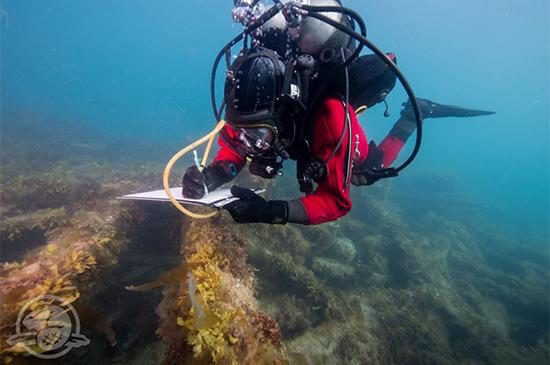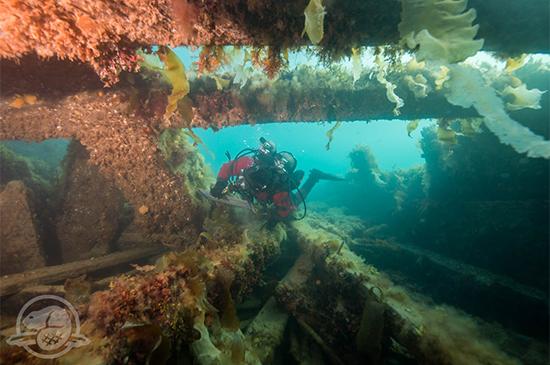Underwater Archeology Team Seeks New Clues to an Old Arctic Mystery

In the largest and most complex underwater archeology undertaking in Canadian history, a Parks Canada team heads north this week to uncover the fate of the disastrous Franklin Expedition of 1845.
Traveling more than 200 kilometers north of the Arctic Circle by boat, a team of nine underwater archeologists from Parks Canada arrived at the wreck site of HMS Erebus on Friday September 14th.
In collaboration with the Inuit Heritage Trust. the expert team will spend the next two weeks exploring the remains of English explorer Sir John Franklin’s ship. They will document and collect artifacts left behind by the crew and Franklin himself from their doomed expedition almost two centuries ago.
This mission, carried out aboard the Agency’s newest research vessel RV David Thompson, will focus on recovering items from the living quarters of the ship. The team hopes that the Arctic waters have preserved Erebus’s ship logs or captain’s journals. These artifacts may hold important clues to the route and final years of the crew. While most artifacts will never be removed from the ships, archeologists hope to collect images, videos, and scans of the wreck. Anything that is removed will be flown to Parks Canada facilities further south for preservation work.
The wreck of the ill-fated expedition resurfaces
One of the most famous Arctic expeditions, the HMS Erebus and HMS Terror were last seen by Europeans entering Baffin Bay, Canada, in August 1845, attempting to traverse the Northwest Passage. Both ships soon became icebound; seeing no other option, the crew abandoned each ship to sink and attempted to trek overland to safety further south. While rescue and recovery missions to find the 133 men were launched from Europe and North America for thirty years, their fates remained lost at sea.
On September 2, 2014, the ship’s location was revealed when Parks Canada announced that the HMS Erebus wreck had been found in shallow waters off the coast of Kind William Island, heavily guided by Inuit oral history and knowledge of the expedition. Together with the HMS Terror, found two years later, the ships are designated as National Historic Sites of Canada.
"With any exploration, the Franklin expedition it is a lesson in what can go very wrong" anthropologist Dr. Lori D’Ortenzio explained to High North News. "It is also an important part of Canadian and British history that is still shrouded in mystery."

Using hair samples to determine the crew’s demise
While Parks Canada searches for clues to the crew’s demise in underwater artifacts, Dr. D’Ortenzio and a team of forensic anthropologists are working to uncover the details of the 133 men’s final years and deaths. Their new research published in The Journal for Archeological Science: Reports analyzes hair samples to dispel the long-held theory that lead poisoning played a role in the deaths of Erebus crew members.
"The research involved hair samples from a crew member, HDS Goodsir whose body had been discovered in the Arctic in 1869," Dr. D’Ortenzio explains.
"He died somewhere between 1846 and 1848. What makes this study unique is that previous studies tested tooth and bone samples from the expedition members which showed high lead levels. Bone and teeth, however indicate lead exposure over decades or over a very long time period."
According to Dr. D’Ortenzio, the advantage of hair samples is that hair grows much quicker, providing her team an opportunity to measure the lead exposure levels in the months just before death during the actual time period that HDS Goodsir lived (and died) during the expedition.
"I believe that this gives us important insights into lead exposure of the crew during the actual expedition verses lead levels that the members may have been exposed to before the expedition as a result of living in Industrial Britain where lead was in many items used in daily life."
Plenty of secrets still left in Arctic detective mystery
Her team found that while lead exposure may have been a contributing factor, it was likely not the main cause of death on the expedition.
"The members of the Franklin expedition were starving, probably dealing with infection, hyperthermia, etc, therefore they had depressed immune systems, all of which was exacerbated by high lead levels," Dr. D’Ortenzio’s team found through forensic analysis, disproving a long-held theory. "Lead likely played a role in the poor decisions that were made by the members. Ultimately the loss of the expedition was a culmination of factors."
It is now up to the Parks Canada’s underwater archeology team to find the rest of those factors over the next two weeks.
"Our research offers a piece of the puzzle in attempting to discovery what actually went on during the expedition," Dr. D’Ortenzio notes, "and I think the continued interest lies in the fact that the Franklin expedition is like a detective mystery that is wrapped up in the historical intrigue of 19th century Arctic explorers."
